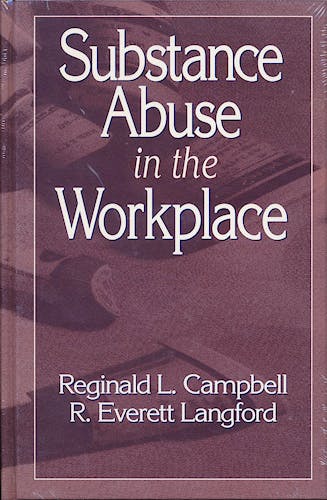

No hay productos en el carrito



Substance Abuse in the Workplace
Campbell, R. — Langford, R.
1ª Edición Abril 1995
Inglés
Tapa dura
224 pags
589 gr
16 x 24 x 2 cm
ISBN 9780873711319
Editorial CRC PRESS
LIBRO IMPRESO
-5%
220,66 €209,63 €IVA incluido
212,17 €201,57 €IVA no incluido
Recíbelo en un plazo de
2 - 3 semanas
Summary
Substance Abuse in the Workplace makes a valuable contribution to the national
movement to help stem the tide of drug abuse. The book begins with the history
of substance abuse, continues with a discussion of how the human body functions
normally or under the influence of chemicals, and follows with a toxicological
description of the more common chemicals abused today in America. It discusses
ways to help the abuser through identification and assistance programs and also
covers the laws involved.
The broad audience for Substance Abuse in the Workplace is includes middle and
upper management, labor leaders, industrial hygienists, safety personnel, and
workers.
Table of Contents
Introduction
Who is This Book For?
Importance of the Problem
Paradigms and Politics
Purpose of This Book
Brief History of Substance Abuse
Introduction
Chemical Dependency and Substance Abuse
Early History
Opium
Coca and Cocaine
Khat
Alcohol
Mushrooms and Other Fungi
Cacti
Marijuana
Nineteenth- and Twentieth-Century Drugs
Summary
How the Human Body Works
Introduction
Definitions
Introduction to Anatomy and Physiology
Respiratory System
Digestive System
Nervous System
Reproductive System
Endocrine System
Blood Circulatory System
Lymphatic System
Urinary System
The Liver
Summary
The Chemistry of Medicinal Substances
Introduction
Definitions
Classes of Common Chemical Substances
Commonly Abused Chemicals
Alcohol
Amphetamines
Barbiturates
Phenothiazines and Benzodiazepines
Alkaloids
Opiates
Cocaine and Cocates
Hallucinogens
Salicylates
Aspirin Substitutes
Marijuana
Steroids
Antihistamines
Bromides
Lithium
Diet Medications
Laxatives
Vitamin Abuse
Designer Chemical Substances
Commercial Products
Over-the-Counter Chemical Substances
Unusual Drugs
Mixing Drugs
Summary
Toxicology of Chemical Substances
Introduction
Definitions
Health Hazards
Acute Exposures
Chronic Exposures
Toxic Classes
Poisoning Potential
Dose Response
Animal Models
Response Curve
Distribution Curve
Cancer and Birth Defects
Teratogens
Mutagens
Carcinogens
Mixtures of Substances
Summary
Interactions with Occupational or Environmental Chemicals
Introduction
Synergistic and Antagonistic Effects
Occupational Exposures and Substance Abuse
Environmental Exposures and Substance Abuse
Summary
Identification of the Substance Abuser
Why Do People Misuse Chemical Substances?
Peer Pressure
Maladapted Response to Stress
Is the Abuser "Different"?
Identification and Recognition of the Substance Abuser
Drug Testing
Summary
Employee Assistance Programs
Introduction
What Is an EAP?
Types of EAPs
Elements of the Program
Administrative Functions
How the Program Works
Five-Step Program to Assist the Employee
Cost Effectiveness of an EAP
National Institute on Drug Abuse Assistance to EAPs
Summary
Laws and Regulations Governing Substance Abuse
Introduction
Early Legislation
Recent Legislation
Physician Licensing and Prescription System
Role of the Food and Drug Administration (FDA)
Drug Schedules
Role of the Drug Enforcement Administration (DEA)
Drug-Free Workplace Act of 1988
Requirements under the Act for Employers
Requirements under the Act for Employees
Summary
Substance Abuse in Specific Work Settings
Introduction
Substance Abuse in the Medical and Allied Sciences Professions
Substance Abuse in the Transportation Industries
Substance Abuse in the Mining and Petroleum Industries
Substance Abuse in the Construction Industries
Substance Abuse in the Clerical Professions
Substance Abuse in the Law Enforcement and Firefighting Professions
Substance Abuse in the Military
Substance Abuse in the Entertainment Industries
Substance Abuse in Sports
Substance Abuse in the Teaching Profession
Substance Abuse in the Manufacturing and Utilities Industries
Substance Abuse in the Warehousing and Sales Industries
Summary
Case Studies and Examples
Use of Case Studies
Case Studies
Some General Conclusions from These Case Studies
A Final Word
Why This Book
What Can Be Done
Conclusion
Appendixes:
A. Chronology of History of Drug Abuse
B. Contacts and Telephone Numbers for Help
C. Procedures for Setting Up Drug Testing Program
D. Model Drug-Free Workplace Program Documents
E. The Employee Assistance Program
Glossary
Bibliography
Index
© 2025 Axón Librería S.L.
2.149.0